RJ-45 GOLD AND NICKEL PLATING ISSUES/PROBLEMS
The RJ-45 Is A Highly Engineered Interconnection System
CAVEAT EMPTOR.....Let The Buyer Beware
SUB-STANDARD, NON-COMPLIANT and COUNTERFEIT RJ45's coming in from the Far East
KNOW THE STANDARDS - KNOW THE SPECS - INSIST ON COMPLIANCE - KNOW YOUR SUPPLIERS
The Telecommunications Industry Association (TIA) has reported that (RJ-45 plug/jack) "connectors continue to be a source of problems for customers. For example, connectors are reaching the marketplace without the requisite amount of gold on the connector contacts." In particular, "such plugs and jacks may be difficult to interconnect and may lack the gold plating on the contact interface needed to prevent interference."
In a recent study, over 50% of all RJ-45 Plugs tested DID NOT MEET THE MINIMUM GOLD and/or NICKEL PLATING REQUIREMENTS PER ANSI/TIA, IEC AND FCC SPECIFICATIONS
BACKGROUND
Bad contacts are the cause of failure or poor performance in a wide variety of electrical devices. For example, corroded jumper cable clamps can frustrate attempts to start a vehicle that has a dead battery. Dirty or corroded contacts on a fuse or its holder can give the false impression that the fuse is blown. A sufficiently high contact resistance can cause substantial heating in a high current device. Unpredictable or noisy contacts are a major cause of the failure of electrical equipment. An intermittent contact which alternates rapidly between a high and low resistance is the worst nightmare of anyone who has to troubleshoot equipment.
Gold plating is often used in electronics, to provide a corrosion-resistant electrically conductive layer on copper. With direct gold-on-copper plating, the copper atoms have the tendency to diffuse through the gold layer, causing tarnishing of its surface and formation of an oxide/sulfide layer. A layer of a suitable barrier metal, usually nickel, has therefore to be deposited on the copper substrate, forming a copper-nickel-gold sandwich.
Phosphor bronze is an alloy of copper with 3.5 to 10% of tin and a significant phosphorus content of up to 1%. The phosphorus is added as deoxidizing agent during melting. These alloys are notable for their toughness, strength, low coefficient of friction, and fine grain.
WHAT THE SPECIFICATIONS CALL FOR
5.1.1 Gold Surface Layer
The gold surface layer in the specified contact interface area shall meet the following requirements:
1. The material content shall be 99% pure gold minimum.
2. The material density shall be 17 grams/cm3 minimum.
3. The minimum gold thickness in the specified interface area shall be 1.2700 μm (50 μin)
4. The Knoop microindention hardness value shall be between 130 and 250 when measured in accordance with ASTM E384-05a using a load force of 0.245 N (25 g).
5. Test specimens shall exhibit no corrosion products having a diameter greater than 0.05 mm (0.002 in) when tested for porosity and other surface defects per EIA-364-53B.
5.1.2 Nickel Barrier Layer
A nickel barrier layer shall be used between the gold surface layer and the base metal. It shall meet the following requirements:
1. The material content shall be 99.5% pure nickel minimum, and no other single component shall be more than 0.2%.
2. The minimum nickel thickness shall be 1.2700 μm (50 μin).
3. The nickel barrier layer shall not crack when a contact sample is bent through a 180° angle, with the plated surface away, around a mandrel whose diameter is equal to the thickness or diameter of the contact sample.
NOTES:
1. The plug/jack contact interface shall be hard gold to hard gold and shall have a minimum gold thickness of 1.2700 μm (50 μin) on each side of the interface. Alternative contact material that is compatible with hard gold and provides equivalent contact performance may be used under certain conditions. The minimum contact force at the interface shall be 0.98 N (100 g). A smooth, burr-free surface shall exist at the interface in the area shown. Contact surface roughness shall be 0.8128 μm (32 μin) maximum. Compliance can be determined by observation with 10X magnification. Compare surface protrusions and burrs on the contact surface with a 32-μin, ground-surface-finish gauge.
2. The jack contact design is based upon 0.4572 mm (0.018 in) spring temper phosphor bronze round wire in the modular plug blade and jack contact interface. Other contact configurations that provide contact performance equal to or better than the preferred configurations and do not cause damage to the plug or jack are permitted. Contact width should be 0.44958/0.49530 mm (0.0177/0.0195 in). Deviations from the desirable jack contact width are permitted for round contacts as well as noncircular cross sectional shapes but they shall be compatible with existing plug configurations.
HERE IS WHAT WE ARE SEEING - YOU WILL NOT BELIEVE IT
NON-COMPLIANCE - CHEATING - COST CUTTING OPERATIONS AFFECTING PRODUCT QUALITY
What you should be aware of when selecting your supplier/partner.
SENTINEL CONNECTOR ELECTRO-POLISHED BURR FREE CONTACT SURFACE
ELECTRO-POLISHING VERSUS WIRE BRUSHING A CRITICAL STEP IN SURFACE PREPARATION OF THE STAMPED CONTACT
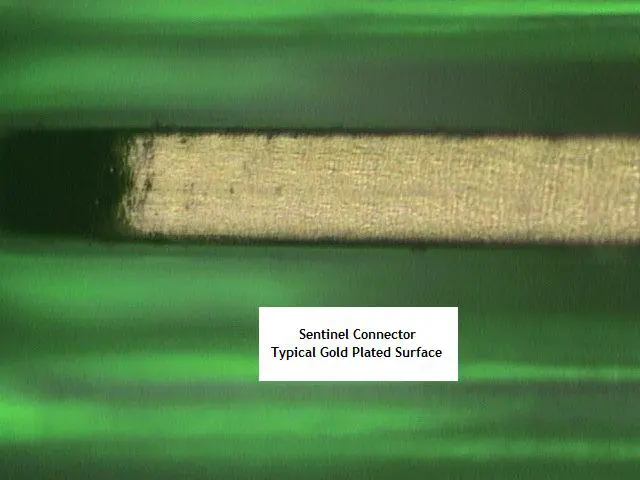
Specifications call for a SMOOTH, BURR FREE CONTACT SURFACE......make sure that the RJ-45's you spec in calls out ELECTROPOLISHING of the surface contact area...... NOT WIRE BRUSHING.
ELECTROPOLISHING - Is a process that electrolytically removes or diminishes scratches, burrs and unwanted sharp edges.....and the desired finish is produced by controlling time, temperature or both. This process creates an extremely smooth contact surface with benefits......when you mate ELECTROPOLISHED plugs and jacks, you are actually "polishing" the contact surfaces. This creates an inverted resistance curve though several hundred insertions-de-insertions. Yes, you actually get better performance and better resistance readings!
BRAND NAME COMPETITOR PLATING SURFACE
WIRE BRUSHING - This is a MECHANICAL PROCESS THAT RUNS WIRE BRUSHES ACROSS THE CONTACT AREA. The consequence is that it creates "RASPS" along the surface, similar to a "WASHBOARD". This creates a CORONA EFFECT during the plating process, whereby, the HILLS on the WASHBOARD will HAVE THE REQUIRED THICKNESS OF GOLD OR NICKEL (maybe) and the VALLEYS WILL NOT HAVE THE DESIRED THICKNESS OF GOLD OR NICKEL.
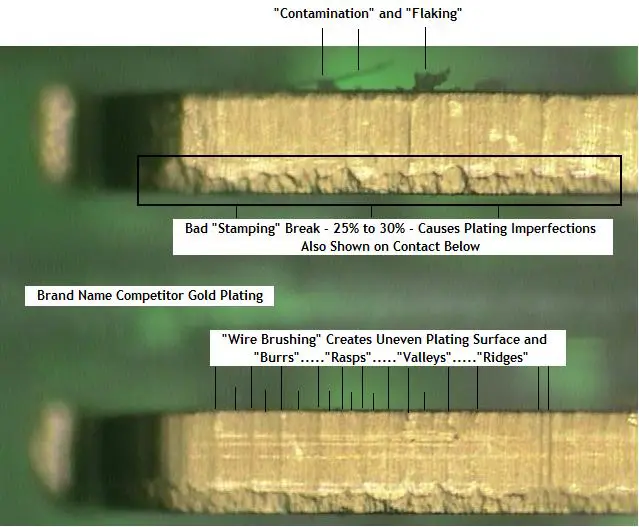
COST FACTORS
Cost pressures have increased on all components, especially those with gold and precious metals involved. Many of these products are subject to offshore outsourcing and subcontractor manufacturing in the supply chain to meet these cost pressures. Unfortunately, quality standards are being compromised. As a result, there is a TICKING TIME BOMB WITH POROSITY, OXIDATION, CONDUCTIVITY, CONTACT RESISTANCE AND CORROSION that may cause complete signal transmission loss or intermittent contact (that alternates rapidly between a high and low resistance), which is the worst nightmare for anyone who has to troubleshoot network equipment.
MAJOR POROSITY ISSUES
One of the issues in the reliability of an electrical contact is the integrity of the plated surface. If there are breaks in the surface, such as pores, then corrosive elements can attack the substrate or the base material. If there are enough pores, corrosion can creep across the surface of the contact with disastrous consequences.
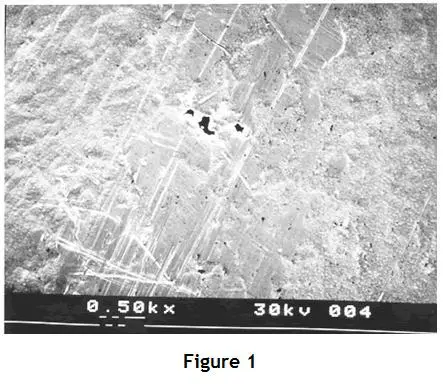
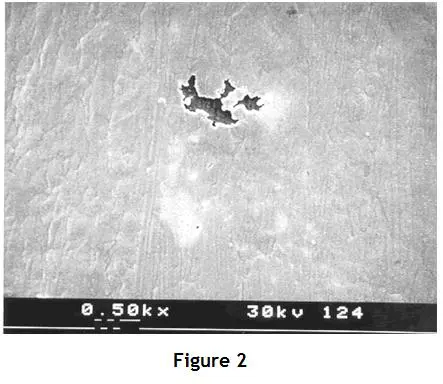
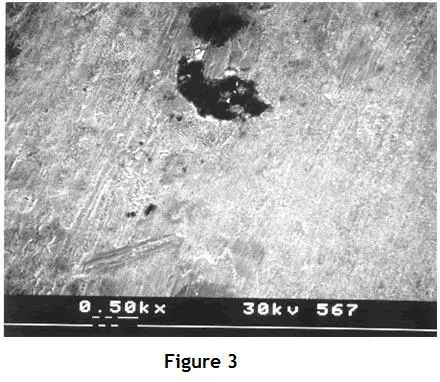
FIGURE 1 - Shows a rather large pore in 50-µinches hard gold over 100-µinches of nickel. While it appears as three pores, it is in fact only one pore structure. A SEM (scanning electron microscope) photo is shown at 500x magnification. Notice the markings on the surface of the part that surround the pore. These nodules and the structure of the orange peel are used as markers to align the part after the gold is removed. In this way the sample can be realigned to the same spot on the contact after removal of the gold and reinsertion into the SEM.
FIGURE 2 - Shows the same pore after chemical removal of the gold but the nickel plating is left intact. What is obvious is the attempt of the nickel to plate over something. The scalloped shape of the edge of the nickel plating is typical of a deposit trying to grow over a non-conductive material. It is also apparent that the gold tried to plate over the void and, if it were any thicker, it may have closed the pore entirely. Note that the nodule and the linear scratch to the left of the pore had been plated with the nickel.
FIGURE 3 - Shows the same pore SEM photo of the base metal. A black material (subsequently identified as organic) is readily seen where the pore originally occurred. There is also a dark spot of contamination above the one that caused the porosity. Other smaller specks are also identified as contamination. The material causing the nodule can be seen next to the scratch in the base material. This non-conductive material is the root cause of the pore. In this image it is difficult to determine if the black is a contaminating material or a hole. In order to verify the findings, the picture is enlarged and overexposed, as seen in Figure 4 below.
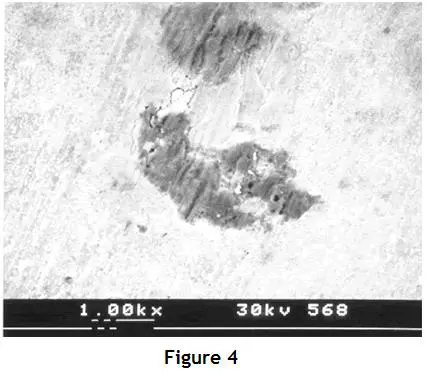
FIGURE 4 - Shows SEM photo at 1000x (overexposed to show the detail of the black material) and is quite diagnostic. First of all, whatever the contaminating material is, it proved sufficiently strong to resist the chemical etchant that removed the nickel. A fine attack on the rest of the copper is evident. The white particles are beryllites, found in all beryllium copper alloys. The dark material at the top of the picture was sufficiently strong to resist etching, but sufficiently conductive to allow electrodeposition. One should question how good the adhesion of the nickel was to such a material.
It is also evident that if the pore had closed over, the plating solution would have been trapped inside. Many corroded contacts show the presence of contaminants such as sulfur, chlorine, and potassium, depending upon which plating solution is trapped. Often, the investigator searches for external sources of this contamination—never expecting little pockets of contaminants resident in the plating itself to surface on a worn contact, exposing the contaminating material.
While the anatomy of the pore pictured above is the result of contaminants on the surface of the base metal, poor quality of the surface finish on the base metal of the contact is a much more common cause of porosity. This originates from a number of sources, but rough die segments and poor die maintenance are the principal culprits. Another common problem area is mechanical scratching from the plating line, or handling or assembly equipment. This is not plating porosity per se but the end result is the same, a compromised gold surface.
GOLD PLATING THICKNESS
Specs call for a MINIMUM 50 MICRO-INCHES OF (PURE) HARD GOLD on the plug/jack contact surface mating areas......buyer beware.......some manufacturers (especially from the Far East) are shipping 30 micro-inches, 15 micro-inches, 6 micro-inches, GOLD FLASH and even COLOR ONLY for their plating! This can have a dramatic effect on the performance of the RJ-45 Interconnection System as it relates to WEAR, OXIDATION, CORROSION and RESISTANCE.
PURITY OF GOLD USED - CARAT
Another aspect of Gold is the Carat selected. The specification calls out for PURE HARD GOLD, 99.99% 24 CARAT......not 18 Carat (75% pure gold - 25% other metal)......not 14 Carat (58% pure gold - 42% other metal) or anything less......sometimes referred to as "jewelry gold". By using these "softer" materials.....you insult the plugs electrical and mechanical integrity. You will not get the same insertion/de-insertion characteristics and you can actually notice the gold rubbing off of the plug contacts after as little as 6 cycles. This dramatically affects the resistance characteristics of the RJ-45 connector system and causes catastrophic failures in HIGH SPEED NETWORKS.
NICKEL PLATING THICKNESS
IT IS MOST DISTURBING TO FIND THAT MANY SAMPLES ANALYZED DID NOT HAVE ANY NICKEL UNDERPLATING.
The specification calls out 50 micro-inches of PURE NICKEL over the phosphor bronze base metal. The nickel acts as a barrier so that the Gold does not diffuse into the base metal (see Gold Diffusion below).
GOLD DIFFUSION "THERE'S NO GOLD ON MY CONTACTS"
The STANDARD/SPECIFICATION process involves "plating a metal barrier, usually nickel, on the copper components (phosphor bronze) and then plating the gold on top of the nickel. Once completed, the gold plated components are corrosion resistant and conductive."
We have observed that some manufacturers are NOT PLATING THE CORRECT THICKNESS of nickel for the barrier.....or NOT USING ANY NICKEL BARRIER AT ALL. With direct gold-on-copper plating, the copper atoms have a tendency to DIFFUSE THROUGH THE GOLD LAYER....the end result....."THERE IS NO GOLD ON MY CONTACTS".....COMPLETE SIGNAL TRANSMISSION LOSS.
GALVANIC REACTION BETWEEN TWO DISSIMILAR METALS
Here is another example of RJ-45 plug/jack manufacturers "CUTTING CORNERS". When you have two dissimilar metals, proper care must be taken to "ACTIVATE" the surfaces during plating.....each plating operation needs the "PROPER CLEANING BATHS" to remove any impurities....and this needs to be adhered to during the "ENTIRE PLATING PROCESS".
We have observed that some RJ-45's on the market are experiencing GALVANIC REACTIONS whereby, the GOLD IS ACTUALLY "LIFTING OFF" or "FLAKING OFF" the contact. How do we know this.....actual customer testimonials. When this occurs, you can have intermittencies, loss of signal and even shorting between contacts.
PLATING STANDARDS, PROCEDURES & BEST PRACTICES NOT BEING FOLLOWED
Here are more examples of RJ-45 manufacturers "CUTTING CORNERS" resulting in some unexpected consequences. Why do companies do this? It saves time and money. The following steps need to be adhered to during the "ENTIRE PLATING PROCESS".
METAL "ACTIVATION" - When you have two dissimilar metals, proper care must be taken to "ACTIVATE" the surfaces during plating using either ACID (bad for the Environment) or CAUSTIC (more expensive) METHODS.
PROPER CLEANING - All items to be plated must be thoroughly cleaned and dried before the plating process begins to remove any impurities. Cleaning takes A LOT OF PURE WATER. Some manufacturers are SKIPPING SOME CLEANSING OPERATIONS or are using re-cycled water using water purification methods. Unfortunately, some of the water purification methods do not provide the QUALITY OF WATER needed for effective cleaning.
DEDICATED PLATING BATHS - Another gold plating issue is the plating bath used to plate the contacts themselves. Several Far Eastern manufacturers do not use dedicated plating baths for their line resulting in significant contamination. If you notice greenish discoloring.....its contaminated.
POOR QUALITY CONTROL
DIFFERENT GOLD PLATING THICKNESS ON THE CONTACTS IN THE SAME PLUG
That's right......we have actually observed RJ-45 plugs that have had DIFFERENT GOLD PLATING THICKNESS ON THE CONTACTS IN THE SAME PLUG........contacts 1, 3, 5 and 7 had 50 micro inches of Gold, while contacts 2, 4, 6 and 8 had only 6 micro inches of Gold! This means that the manufacturer is offering different options to its customers and did not have the right QC procedures in place to build the product correctly.
What does this all mean.....by not using the right gold, enough gold or the right manufacturing processes, you could have significant porosity, flaking and integrity issues that alter both the electrical and mechanical attributes of the RJ-45 Interconnection System.
HOW WE DO THINGSTHE SENTINEL CONNECTOR SYSTEMS ADVANTAGE

Sentinel Connector Systems is the premier "MADE IN USA" manufacturer of RJ-45 Plugs and Jacks. As a matter of fact, their Founder was part of the original design team at Hardesty that actually built the first RJ type connector ever. We have the BOOK OF RJ.....representing over 40 years of hand written notes about the why's and dont's of manufacturing RJ-45 Interconnection Systems.
THE BOOK OF RJ (Robert J Brennan)

WE DO EVERYTHING FOR A REASON
The guys at Sentinel have OVER 300 MAN YEARS OF EXPERIENCE, HOLD 35 RJ45 RELATED PATENTS and HAVE THE ANSWERS to all of your RJ-45 related questions. We are just a phone call or email away.
THE SENTINEL CONNECTOR SYSTEMS ADVANTAGE - All of Sentinel's Plugs and Jacks are built in accordance to INDUSTRY STANDARDS & SPECIFICATIONS as set forth by governing bodies such as ACTA, ASTM, EIA, FCC, IEC, IEEE, ISO, TIA and UL. Sentinel is also a Member of the Communications Cable and Connectivity Association.....adhering to the Association's STRICT CODE OF ETHICS regarding compliance.
The BASIS METAL for the contacts is PHOSPHOR BRONZE. We use a very specific % along with a very tightly controlled min-max granular MICROSTRUCTURE to provide the best STIFFNESS, SPRING QUALITIES and CORROSION & WEAR RESISTANCE. The base metal is then ELECTROPOLISHED (versus wire brushed) creating an extremely smooth "BURR FREE" CONTACT SURFACE. It is then plated with 100 micro inches of pure Nickel (min plugs, 50 micro min jacks)....providing a sacrificial metal surface/barrier to PROHIBIT DIFFUSION and OBTAIN DESIRED POROSITY CHARACTERISTICS....then 50 micro inches (minimum) of pure 24 CARAT (hard) GOLD adhering to MIL-G-45204C, TYPE II, GRADE A specifications and Knoop Hardness requirements. During each plating operation, PROPER SURFACE ACTIVATION and CLEANSING PROCEDURES are meticulously followed to insure against any possible surface contamination and potential GALVANIC REACTIONS (reference MIL-STD-889).
By incorporating the strict design guidelines above, Sentinel Plugs and Jacks will have a MINIMUM 1,000 CYCLE LIFE (insertions/de-insertions) before any degradation of surface contact areas and a 2,000 MINIMUM CYCLE LIFE WHEN USING SENTINEL PLUG/JACK COMBINATIONS.
THE BOTTOM LINE - WE DO NOT CUT CORNERS.....WE USE BEST PRACTICES.....WE MEET and/or EXCEED ALL STANDARDS....WE PROVIDE THE HIGHEST QUALITY IN THE MARKETPLACE.....and best yet, WE ARE EASY TO WORK WITH and our products are MADE IN THE UNITED STATES OF AMERICA.
